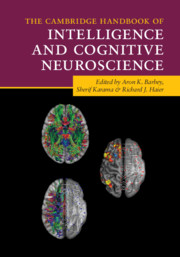Book contents
- The Cambridge Handbook of Intelligence and Cognitive Neuroscience
- Reviews
- The Cambridge Handbook of Intelligence and Cognitive Neuroscience
- Copyright page
- Dedication
- Contents
- Figures
- Tables
- Contributors
- Preface
- Part I Fundamental Issues
- Part II Theories, Models, and Hypotheses
- 5 Evaluating the Weight of the Evidence
- 6 Human Intelligence and Network Neuroscience
- 7 It’s about Time
- 8 A Lifespan Perspective on the Cognitive Neuroscience of Intelligence
- 9 Predictive Intelligence for Learning and Optimization
- Part III Neuroimaging Methods and Findings
- Part IV Predictive Modeling Approaches
- Part V Translating Research on the Neuroscience of Intelligence into Action
- Index
- References
5 - Evaluating the Weight of the Evidence
Cognitive Neuroscience Theories of Intelligence
from Part II - Theories, Models, and Hypotheses
Published online by Cambridge University Press: 11 June 2021
- The Cambridge Handbook of Intelligence and Cognitive Neuroscience
- Reviews
- The Cambridge Handbook of Intelligence and Cognitive Neuroscience
- Copyright page
- Dedication
- Contents
- Figures
- Tables
- Contributors
- Preface
- Part I Fundamental Issues
- Part II Theories, Models, and Hypotheses
- 5 Evaluating the Weight of the Evidence
- 6 Human Intelligence and Network Neuroscience
- 7 It’s about Time
- 8 A Lifespan Perspective on the Cognitive Neuroscience of Intelligence
- 9 Predictive Intelligence for Learning and Optimization
- Part III Neuroimaging Methods and Findings
- Part IV Predictive Modeling Approaches
- Part V Translating Research on the Neuroscience of Intelligence into Action
- Index
- References
Summary
The goal of this chapter is to provide an overview and critique of the major theories in the cognitive neuroscience of intelligence. In taking a broad view of this literature, two related themes emerge. First, as might be expected, theoretical developments have generally followed improvements in the methods available to acquire and analyze neural data. In turn, as a result of these developments, along with those in the psychometric and experimental literatures, cognitive neuroscience theories of intelligence have followed a general trajectory that runs from relatively global statements early on, to increasingly precise models and claims. As such, following Haier (2016), it is perhaps most instructive to divide the development of these models into early and later phases.
- Type
- Chapter
- Information
- Publisher: Cambridge University PressPrint publication year: 2021



